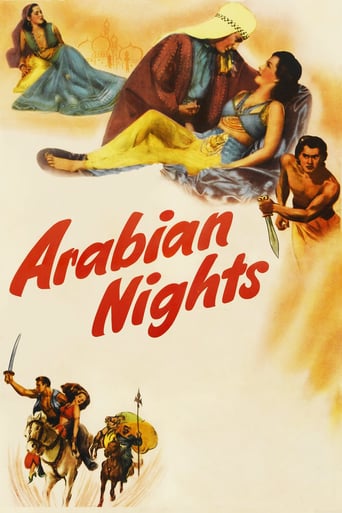MARIO GAUCI
I had long wanted to revisit this one since my one and only viewing of it had occurred long ago (back in the mid-1980s) and given that I am partial to Arabian Nights extravaganzas. Frankly, I was very disappointed that Universal decided to issue this one on DVD by itself a couple of years ago instead of releasing a Franchise Collection comprising several of its equally colorful follow-ups from the same studio; in the end, I didn't pick the disc up but, in view of the problematic copy I eventually ended up with, it would perhaps had been wiser if I did! In fact, when I first acquired it on DivX, there were severe lip-synch problems; this was remedied when I eventually converted it onto DVD-R but then there was intermittent jerkiness to the picture. Furthermore, when I played it on my Pioneer model, the picture froze with a loud buzz…thankfully, this was not repeated when I placed it into my cheaper DVD player and even the jitters were less conspicuous! Anyway, this movie has a lot to answer for: it was the ideal form of cinematic escapism for WWII picturegoers and reaped big box office returns for Universal which ensured that they went back to the desert of Arabia for many more times thereafter in the next decade or so. Despite the generic title, the film isn't actually a filmic depiction of one of the classic stories but rather Universal's own concoction with every known ingredient thrown into the mix for added value: so it is that historical figures (Haroun-Al-Raschid) rub shoulders with mythical ones (Sinbad, Aladdin, Scheherazade) and are subverted or sanitized into the process. Dashing hero Jon Hall plays Haroun-Al-Raschid as a deposed Caliph seeking to regain his throne usurped by his villainous and seemingly love-crazed brother (Leif Ericson); the object of his unrequited affections is Scheherazade – which is actually misspelled in the credits! – played by the iconic "Queen of Technicolor" Maria Montez. Sinbad and Aladdin, then, are incongruously but humorously portrayed as amiable buffoons by familiar character actors John Qualen and Shemp Howard respectively; the latter is always on the point of spinning one of his seafaring yarns yet again before being shut up by his ill-tempered circus employer Billy Gilbert! The third lead role is taken by exotic Indian star Sabu who had already visited this territory in the quintessential Arabian Nights tale (and definitive film), the magnificent Alexander Korda production of THE THIEF OF BAGDAD (1940); what the film under review lacks in comparison to the latter is the omission of wizardry and special effects.As I said, this formula proved so successful that Universal reunited variations of the star combo several times afterwards – WHITE SAVAGE (1943), ALI BABA AND THE FORTY THIEVES (1944), COBRA WOMAN (1944; see above), GYPSY WILDCAT (1944), SUDAN (1945; also helmed by Rawlins) and TANGIER (1946). Another measure of its being welcome at the time of release is the fact that ARABIAN NIGHTS was nominated for 4 Academy Awards in these categories: art direction-set decoration, cinematography (this was Universal's first three-strip Technicolor production and, over 60 years later, the colors still leap off the screen), music (Frank Skinner's score is appropriately rousing) and sound recording. In this context, the choice of John Rawlins as director – best known for the rather weak SHERLOCK HOLMES AND THE VOICE OF TERROR (1942) – was a curious one but, in hindsight, he conducted the proceedings very capably.
rebeljenn
This action-packed adventure film is worth a watch, but it is not exactly a memorable film, and the story line suffers - secondary to all of the action taking place. (The basic summary is about a man who ends up getting revenge and banding together with some close friends, including a slave girl who is his love interest.) It is a fun film, and the picture (shot in Technicolour) is beautiful. (Excellent landscapes, colourful costumes, and much more come to life in the vibrant colour that this film was shot in.) If you want to watch something fun that doesn't require much thinking, then this movie won't let you down.5/10
Nazi_Fighter_David
After her adoring audience had grown up, they discovered that Maria Africa Vidal de Santo Silas (born 1920, died 1951) hadn't done her own singing (she was dubbed), nor her own dancing; her ability as an actress was also put into question, but her spell was not tarnished...Maria Montez was still the madly glamorous South American 'Queen of Technicolor'. What her roles (all of them variations of Scheherazade) required were ingredients she had a surplus of: statuesque bearing, regal demeanor, fiery beauty and, best of all, an unassailable confidence in herself… When one weighed all the things she couldn't do against the thing she did so well, the balance came out in her favor…Her film, "Arabian Nights," is a well presented oriental adventure which has nothing to do with its source material but entertained multitudes in search of relief from total war and was followed by several vaguely similar slices of hokum with the same stars...
ctosangel-2
I do not understand why the video movie pack shows John Hall when really movie 80% begin to Maria Montez and 20% to Sabu. The story (Boardman and Hogan), an inoffensive comedy in the orientalism way from the 40', the same that decorates and costumes. Very caracterist in that Hollywood era. Splendid technicolor and adequate music from Frank Skinner.




